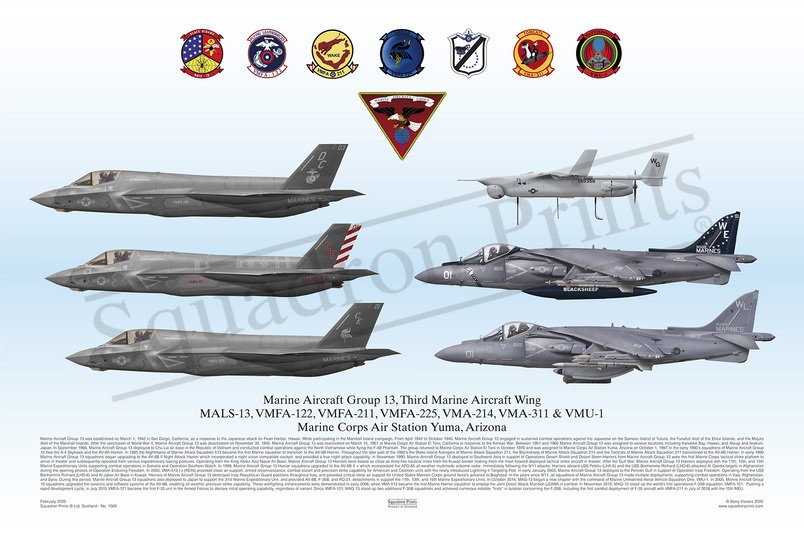#1563 Marine Aircraft Group 13

Description
Squadron Prints Lithograph No. 1563 - Marine Aircraft Group 13, Third Marine Aircrat Wing. MALS-13, VMFA-122, VMFA-122, VMFA-211, VMFA-225, VMA-214, VMA-311 & VMU-1. Marine Corps Air Station Yuma, Arizona.
Marine Aircraft Group 13 was established on March 1, 1942 in San Diego, California, as a response to the Japanese attack on Pearl Harbor, Hawaii. While participating in the Marshall Island campaign, From April 1942 to October 1945, Marine Aircraft Group 13 engaged in sustained combat operations against the Japanese on the Samoan Island of Tutuila, the Funafuti Atoll of the Ellice Islands, and the Majuro Atoll of the Marshall Islands. After the conclusion of World War II, Marine Aircraft Group 13 was deactivated on November 30, 1945. Marine Aircraft Group 13 was reactivated on March 15, 1951 at Marine Corps Air Station El Toro, California in response to the Korean War. Between 1951 and 1965 Marine Aircraft Group 13 was assigned to various locations including Kaneohe Bay, Hawaii, and Atsugi and Iwakuni, Japan. In September 1966, Marine Aircraft Group 13 deployed to Chu Lai air base in the Republic of Vietnam and conducted combat operations against the North Vietnamese while flying the F-4B Phantom. The group returned to Marine Corps Air Station El Toro in October 1970 and was assigned to Marine Corps Air Station Yuma, Arizona on October 1, 1987.In the early 1980’s squadrons of Marine Aircraft Group 13 flew the A-4 Skyhawk and the AV-8A Harrier. In 1985 the Nightmares of Marine Attack Squadron 513 became the first Marine squadron to transition to the AV-8B Harrier. Throughout the later part of the 1980’s the Wake Island Avengers of Marine Attack Squadron 211, the Blacksheep of Marine Attack Squadron 214 and the Tomcats of Marine Attack Squadron 311 transitioned to the AV-8B Harrier. In early 1990 Marine Aircraft Group 13 squadrons began upgrading to the AV-8B II Night Attack Harrier which incorporated a night vision compatible cockpit, and provided a true night attack capability. In November 1990, Marine Aircraft Group 13 deployed to Southwest Asia in support of Operations Desert Shield and Desert Storm.Harriers from Marine Aircraft Group 13 were the first Marine Corps tactical strike platform to arrive in theater and subsequently operated from various expeditionary basing postures. Operating from the King Abdul Aziz Naval Air Base, Marine Aircraft Group 13 Harriers were based as close as thirty-five nautical miles from the Kuwait border making them the most forward deployed tactical strike aircraft in theater. After the Gulf War, Marine Aircraft Group 13 Harriers deployed with the 11th, 13th, and 15th Marine Expeditionary Units supporting combat operations in Somalia and Operation Southern Watch. In 1999, Marine Aircraft Group 13 Harrier squadrons upgraded to the AV-8B II + which incorporated the APG-65 all-weather multimode airborne radar. Immediately following the 9/11 attacks, Harriers aboard USS Peleliu (LHA-5) and the USS Bonhomme Richard (LHD-6) attacked Al Qaeda targets in Afghanistan during the opening phases of Operation Enduring Freedom. In 2003, VMA-513 (-) (REIN) provided close air support, armed reconnaissance, combat escort and precision strike capability for American and Coalition units with the newly introduced Lightning II Targeting Pod. In early January 2003, Marine Aircraft Group 13 deployed to the Persian Gulf in support of Operation Iraqi Freedom. Operating from the USS Bonhomme Richard (LHD-6) and Al Jaber Air Base in Kuwait, Harriers of Marine Aircraft Group 13 destroyed Iraqi Republican Guard positions throughout Iraq, and provided critical close air support for United States Marines Corps ground force’s advance to Baghdad. In the years since 9/11, all squadrons of Marine Aircraft Group 13 made multiple deployments, supporting combat operations in Iraq, Afghanistan, and Syria. During this period, Marine Aircraft Group 13 squadrons also deployed to Japan to support the 31st Marine Expeditionary Unit, and provided AV-8B, F-35B, and RQ-21, detachments in support the 11th, 13th, and 15th Marine Expeditionary Units. In October 2014, MAG-13 began a new chapter with the command of Marine Unmanned Aerial Vehicle Squadron One, VMU-1. In 2005, Marine Aircraft Group 13 squadrons upgraded the avionics and software systems of the AV-8B, enabling all weather precision strike capability. These warfighting enhancements were demonstrated in early 2006, when VMA-513 became the first Marine Harrier squadron to employ the Joint Direct Attack Munition (JDAM) in combat. In November 2012, MAG-13 stood up the world’s first operational F-35B squadron, VMFA-121. Pushing a rapid development cycle, in July 2015 VMFA-121 became the first F-35 unit in the Armed Forces to declare initial operating capability, regardless of variant. Since VMFA-121, MAG 13 stood up two additional F-35B squadrons and achieved numerous notable “firsts” in aviation concerning the F-35B, including the first combat deployment of F-35 aircraft with VMFA-211 in July of 2018 with the 15th MEU.
You may also like
-
617 Squadron 80th Anniversary PVC Patch (2nd Edition 9cm)
617 SqnRAF Marham; HMS Queen Elizabeth -
SALE Typhoon FGR4 11(Fighter) Squadron Spearhead Patch
11 SqnRAF Coningsby
